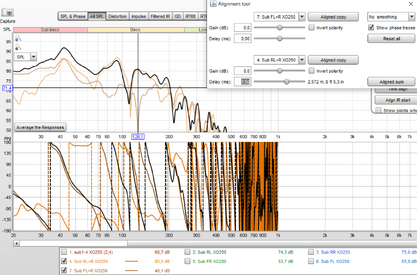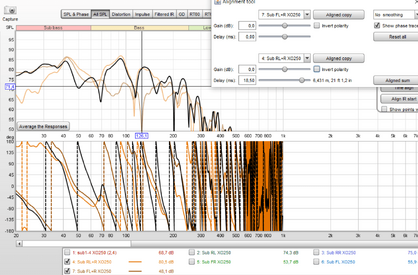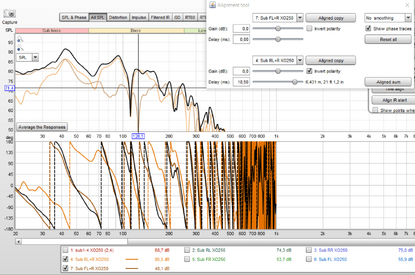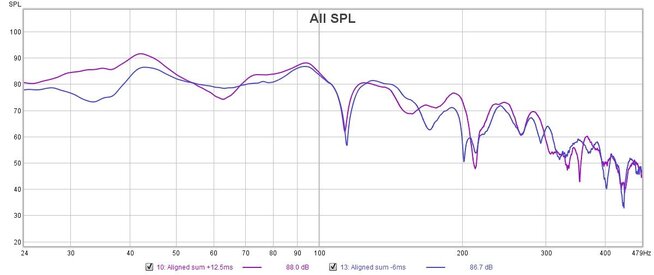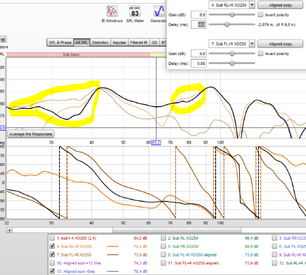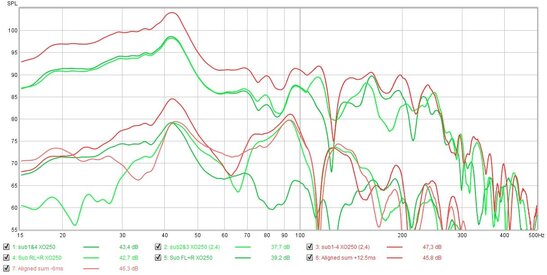Niklasmagnus
Registered
Thread Starter
- Joined
- Dec 25, 2018
- Posts
- 28
Hi,
Just want to get a few things clear regarding multi-sub alignment, sub to main alignment and EQ set up.
I been using REW a few time and know the software I believe quite good, but don’t always know how to set up measurements or how to do the analyses. Just did some playing around a few hours since I added the fourth sub (middle right in series with middle left) with 1 point (MLP) measuring to set the subs alignment and test eq. I have added the mdat file for the session, “Measures.zip”. I run 2 subs in series per channel, total 4 subs.
I have tried and delay of middle subs compared to the corner subs by checking SPL sum over the bass area, and 2,4 ms delay looked best in my opinion. But this I still only measured from one point, MLP. Mdat: “mic 77cm Set delay 4 subs minidasp.mdat”.
Also tested different XO, and I think 150Hz looks best.
Added near filed measurement from each sub and reference: “SUB 3 cm.mdat”
Question 1
Correct to do multi-sub alignment from one measuring point, MLP? Or must I take multiple around MLP or even around my 3 seat sofa, and average. but how step by step?
If okey from one point, what do you think about the result of chanel 2 delayed 2,4 ms?
Question 2
Correct to do main Right (or left) – subs alignment from one measuring point, MLP? Or must I take multiple around MLP or even around my 3 sit sofa, and average, but how step by step?
If okey from one point, what do you think about the result of subs delayed 3.12m to main (R at 3,45m in AVR)? Measurement “Sub1-4XO150 2,4//3,95*” in “Measures.mdat”.
Question 3
What is minimum measuring points for EQ the sub? And since I´m using Marantz SR7009 I can do some eq on LCR also but then I need FDW cycles to get correct results? How many cycles? This feature is new to me.
Thanks
Niklas
Just want to get a few things clear regarding multi-sub alignment, sub to main alignment and EQ set up.
I been using REW a few time and know the software I believe quite good, but don’t always know how to set up measurements or how to do the analyses. Just did some playing around a few hours since I added the fourth sub (middle right in series with middle left) with 1 point (MLP) measuring to set the subs alignment and test eq. I have added the mdat file for the session, “Measures.zip”. I run 2 subs in series per channel, total 4 subs.
I have tried and delay of middle subs compared to the corner subs by checking SPL sum over the bass area, and 2,4 ms delay looked best in my opinion. But this I still only measured from one point, MLP. Mdat: “mic 77cm Set delay 4 subs minidasp.mdat”.
Also tested different XO, and I think 150Hz looks best.
Added near filed measurement from each sub and reference: “SUB 3 cm.mdat”
Question 1
Correct to do multi-sub alignment from one measuring point, MLP? Or must I take multiple around MLP or even around my 3 seat sofa, and average. but how step by step?
If okey from one point, what do you think about the result of chanel 2 delayed 2,4 ms?
Question 2
Correct to do main Right (or left) – subs alignment from one measuring point, MLP? Or must I take multiple around MLP or even around my 3 sit sofa, and average, but how step by step?
If okey from one point, what do you think about the result of subs delayed 3.12m to main (R at 3,45m in AVR)? Measurement “Sub1-4XO150 2,4//3,95*” in “Measures.mdat”.
Question 3
What is minimum measuring points for EQ the sub? And since I´m using Marantz SR7009 I can do some eq on LCR also but then I need FDW cycles to get correct results? How many cycles? This feature is new to me.
Thanks
Niklas








